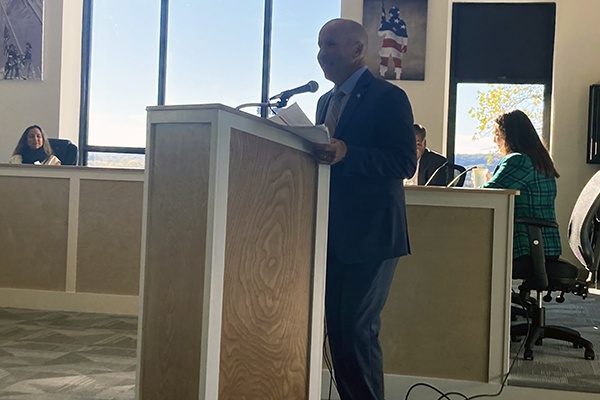|
RCBJ-Audible (Listen For Free)
|
Panelists Lay Out Brownfield And Historic Preservation Strategies But Emphasize Need for Public Consensus on Property’s Future Development
By Tina Traster
Letchworth Village in Stony Point is a ghostly and haunting reminder of a bygone era of psychiatric institutions. The once austere but magnificent stone buildings sag with neglect from decades of disuse and disrepair. Trees sprout through roofs like ironic reminders that new life always takes root in a void, which is what many still hope for the site.
Mimi Raygorodetsky, principal from Langan Engineering, added “You might qualify for financial benefits – not just $5 million to clean up but you can get $35 million in tax credits.”
Perhaps no one feels more haunted by Letchworth Village than Jim Monaghan, Stony Point’s Supervisor, who has gone to battle unsuccessfully twice in the space of two years to steer a new plan for the fallow fields of the former psychiatric campus.
By all accounts, there is little advantage to keeping a 20-acre site rife with environmentally contaminated buildings in a state of inertia – though that has been the case since the town bought the land from New York State in 1999 for $3 million. On the other hand, Monaghan and developers who have met with gale force winds of opposition, have learned that an anti-development, anti-housing sentiment in town will continue to thwart future housing proposals unless town officials undertake a pre-emptive educational and consensus-building approach to gain support for redeveloping the fallow site.
To begin that process, Monaghan last week invited a panel of experts to the town to participate in a think-tank style conference: Breaking Brownfields: Exploring Redevelopment Opportunities in the Lower Hudson Valley. Urban Land Institute Westchester/Fairfield, in partnership with New Jersey Institute of Technology Technical Assistance to Brownfield Communities, co-hosed the event, which took place at the town’s new community center at Patriot Hills.
“The town has been looking to attract a developer,” said Monaghan, adding the town passed a zoning overlay in 2015 to allow a list of things “that residents wanted to see.” That list included recreation, senior housing, town homes, and hotels. “We’ve had different opportunities to repurpose or refurbish” the site but “the proposals did not go anywhere.”
In 2021 and again in 2022, residents quashed two development proposals through voter referendums.
In 2021, a slim majority of Stony Point voters said no to a proposed development by local businessman Raja Amar because they worried about the developer’s inexperience and because the rigidity of an already-negotiated contract to sell both the land and the Patriot Hills golf course left too little wiggle room for change. Amar had hoped to build a hotel and housing on the site but had not presented concrete plans or renderings. It was difficult for residents to envision what would happen on the site.
Additionally, some residents planted the notion the site would be bought and flipped for dense housing to the Hasidic community if Amar’s plans collapsed. That messaging featured as a key talking point in the race for Stony Point Town Supervisor that year.
“This was the worst,” said Monaghan. “There was a mailer with a picture of Patriot Hills golf course next to Kiryas Joel,” he said, referring to the densely developed Hasidic community in Orange County. “This mailer was filled with hate and misinformation, but it gained traction.”
In 2022, for the second time in two years, voters more resoundingly (70 percent to 30 percent) defeated a proposed development from an experienced Westchester developer who had proposed a multi-generational plan that included millennial and senior housing. That time around, the proposed development did not include the sale of the town-owned Patriot Hills Golf Course.
But an emboldened coalition used similar tactics to suggest the development would potentially be abandoned and flipped to a housing developer for Hasidic communities. The tactics worked – leaving town officials defeated even though they understand that leaving Letchworth to continue to rot is neither sustainable nor responsible.
“This was a really good product – a great builder with a greater reputation who was going to build 150 homes for seniors, 100 townhouses, 100 condos,” he said. “It would have put Letchworth back on the tax rolls. I really thought it would pass. But again we were dealing with social media haters. Misinformation.”
In the spirit of perseverance, Monaghan convened the “think” session that included a panel of land-use lawyers, builders, engineers, and Orangetown Supervisor Teresa Kenny. Panelists initially spoke about a raft of opportunities for towns to assess and apply for state and federal grants to clean up brownfield sites. The Letchworth property, with buildings filled with asbestos and lead contamination in and around the buildings, likely meets the brownfield definition. Speakers also said the site could be eligible for state historic preservation grants if the property is listed on the State or National Historic Register.
“It’s a gorgeous site with lots of potential,” said Julia Martin, a lawyer with Bousquet Holstein PLLC.
Mimi Raygorodetsky, principal from Langan Engineering, spoke about grant opportunities, adding “You might qualify for financial benefits – not just $5 million to clean up but you can get $35 million in tax credits.”
Funding for brownfields cleanup and redevelopment typically comes from multiple sources, including the New York Department of State Brownfield Opportunity Area, the New York State Department of Environmental Conservation Brownfield Cleanup Program, Empire State Development, Community Development Block Grant Vacant Property Clearance Program and the EPA’s 2025 EPA Brownfield Cleanup Grant, as well as the 2025 EPA Brownfield Revolving Loan Fund.
In the New York Department of Environmental Conservation Brownfield Cleanup Program, for example, sites meet the definition when a contaminant is present at levels exceeding the soil cleanup objects or other health-based or environmental standards.
Eligible municipalities can apply for up to $1 million for vacant building clearance, environmental site assessments, site work, soft costs and environmental mitigation related to paint and asbestos via the Community Development Block Grant Vacant Property Clearance Program.
And federal funding through the EPA 2025 Brownfield Cleanup Grant is available to local governments, including up to $4 million in cleanup funding, which includes asbestos and lead paint abatement.
While some of the discussion focused on avenues for environmental cleanup funding, the more poignant part of the discussion may have been a back-to-basics reminder: Stony Pointers must be sold on a development plan or a combination of plans that a majority can agree with. The sale of town-owned property can trigger a public referendum that could reject the sale and void a sales contract.
Builder Ken Kearney, president of Kearney Realty Group, shrewdly said, “Anything would work here. But the question is how to gather community support. What tools do you need. It’s a campaign. What platform will allow you to get a referendum over the finish line?”
Echoing that sentiment, Neil Alexander, a partner with Cuddy Feder, said, “You will not have trouble attracting development because (Letchworth Village) has great bones, caliber.” The challenge, he said, is for Stony Point to “engage the majority.”
Alexander veered off into a wider discussion about the danger of allowing Stony Point’s population to atrophy. “In the next eight years, the school district population will fall by 20 percent.” He said the town needs starter housing for millennials with children, “as opposed to hollowing out in place.”
Panelists threw in suggestions ranging from holding charrettes to pop-up events to door knocking.
Kearney recommended simultaneously launching brownfield applications and a public awareness campaign to build an early and invested coalition of citizens.
“Build support from the ground up,” he said. “It doesn’t hold you to one vision.”
One piece of advice several panelists chimed in on is that doing nothing isn’t free. There is the cost and upkeep of the fallow campus, along with the fact that it remains off the tax rolls.
“Not doing anything, maintaining the status quo,” Alexander said, “seems like it’s not a decision but it is a decision.”
















